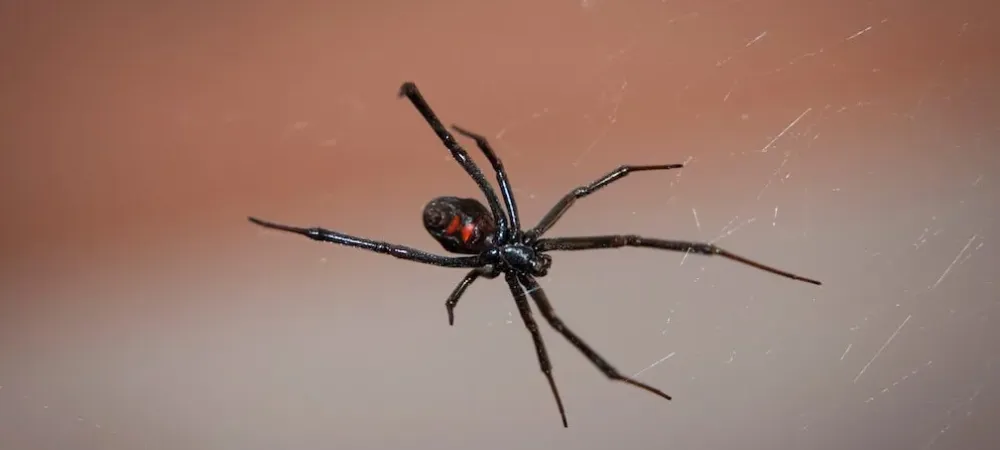Black Widow Spider Facts

Many people are terrified of black widow spiders. Female black widow spiders are indeed dangerous to humans, even if the level of danger that they pose to humans is hugely exaggerated. People will potentially manage to protect themselves if they are able to spot black widow spiders at the right time. Knowing more information about black widow spiders can help people defend themselves against them.
Black Widow Facts
- Female black widow spiders are truly the most venomous spiders on the entire North American continent. However, the black widow is far from the most dangerous arachnid in the world.
- While it is true that female black widow spiders will kill and eat their mates after the mating process, it doesn't happen all the time and it is not required.
- The black widow spider web is the strongest type of spider web. In fact, it’s five times stronger than steel.
- Black widow spiders eat small pests such as ants and silverfish, meaning they may actually be beneficial for your home.
What Does a Black Widow Spider Look Like?
- Female black widow spiders have red hourglass markings on the side of the abdomen that typically faces the ground. Otherwise, their bodies are entirely shiny black.
- Male black widow spiders are easily distinguished from the venomous females. They have different markings from females, with red and yellow bands and spots on their backs. The male black widow spider also has longer legs and half as long bodies.
- Juvenile black widow spiders look just like the males.
How Common Are Black Widows?
Most people in North American will go their entire lives without ever seeing a black widow spider. Black widow spiders are primarily found in warmer climates. People living in the American Southwest will be more likely to see them than the people living in the American Northeast, for instance. As a general rule, people will be more likely to see black widow spiders at a latitude of 45 degrees North and South.
Can You Die from a Black Widow Spider Bite?
The good news is that people actually rarely die after being bitten by female black widow spiders. In fact, the human mortality rate from black widow spiders is less than one percent. The spiders will only inject a relatively small quantity of poison during a particular bite. This is more than enough poison to kill an insect, which is what a black widow spider will eat. Black widow spiders will rarely encounter animals that are as large as humans in the wild, and large animals are much more likely to be able to withstand toxins that will kill smaller animals. People certainly don't have to live in fear of black widows.
Black Widow Spider Bite Symptoms
People might develop many different symptoms after getting bitten by a black widow spider. Some of these symptoms might be mistaken for the symptoms of another disease, especially if the patient in question has a tendency to get sick.
Symptoms of a black widow spider bite include:
- Nausea
- Dizzy spells
- Swelling and pain at the site of the bite
- Chest pains
- High blood pressure
- Headache
- Salivation
- Watering of the eyes
- Rash
- Itching
- Breathing troubles
- Swelling of the eyelids.
What Do I Do If I’m Bitten by a Black Widow?
Washing the bite, applying an antibiotic cream, and then applying an ice pack to the wound can really help in the meantime. However, these are not the ultimate solutions to the problem. If you suspect that you’ve been bitten by a black widow spider, you should still go to the emergency room. If it is possible, someone should try to capture and save the original spider for the sake of identification. However, this is something of a risky procedure, so people should be careful about this step.
Do Male Black Widows and Juvenile Black Widow Spiders Bite?
Male black widow spiders and juvenile black widow spiders are harmless to humans. It is possible that they might bite defensively, but it's unlikely. If they did bite, it would not be dangerous. Male black widow spiders and the juvenile black widow spiders do not tend to be aggressive, and they are much more likely to avoid humans, so this is not something that people should generally fear.
The Black Widow Life Cycle & the Juvenile Black Widow
Mating season for black widows, like most animals, is springtime and early summer. Black widows can produce hundreds of eggs in one egg sac, and multiple egg sacs per mating season. These egg sacs stay tightly woven in the web until they hatch.
Juvenile black widows tend to eat their siblings after hatching, meaning only a handful survive from each egg sac. As time goes on, the juvenile black widow will spin their own web in order to grow and stay alive during winter.
Black widow spiders tend to live 1-3 years, but usually closer to one.
Need Black Widow Spider Control in Northern CA?
Even though black widow spiders can be beneficial to your home, they still can cause a lot of stress and anxiety—especially if you already know that you are allergic to spider bites. If you have a black widow spider infestation, give Big Time Pest Control a call. Our spider control services include black widows, and we’ll be happy to give you your peace of mind back.
